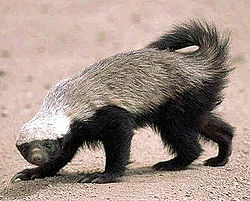Aposematismo


Aposematismo (el la greka ἀπό apo for, σ̑ημα sema signalo, stampita de Edward Bagnall Poulton[1][2]), aŭ predantoforigo, eble plej ofte konata en la kunteksto de averta koloraro priskribas familion de kontraŭpredantaj adaptoj en kiuj averta signalo estas asocia kun la neprofiteblo de tia predo al eblaj predanton.[3] Aposematismo ĉiam inkludas avertajn signalojn. Aliaj avertaj signaloj estas la brilaj koloroj de floroj kiuj allogas polenistojn. La averta signalo povas preni la formon de rimarkinda animala koloraro, sonoj, odoroj[4] aŭ aliaj percepteblaj karakteroj. Aposemataj signaloj estas profitaj kaj por la predanto kaj por la predo, ĉar ambaŭ evitas eblajn damaĝojn.
Aposematismo estas uzata por la tiel nomata Milera kamuflimito, per kiuj specioj kun fortaj defendoj evoluas por simili unu al alia. Per tiu kamuflimito de similkoloraj specioj, la averta signalo al eblaj predantoj estas kunhavata, farante ilin lerni pli rapide kontraŭ malpli kosto de ĉiu specio.
Referencoj
[redakti | redakti fonton]- ↑ Poulton, 1890. Foldout "The Colours of Animals Classified According to Their Uses", post paĝo 339.
- ↑ Marek, Paul. "Aposematism". Apheloria. [1] Alirita la 7an de Majo, 2016.
- ↑ (2003) “Multiple, recurring origins of aposematism and diet specialization in poison frogs”. doi:10.1073/pnas.100.22.12792.
- ↑ (1981) “Toxicity, Odor Aversion, and 'Olfactory Aposematism'”, Science 213 (4506), p. 476. doi:10.1126/science.7244647.
Literaturo
[redakti | redakti fonton]- Capinera, John L., eld. (2008). Encyclopedia of Entomology (2nd ed.). Springer. ISBN 978-1-4020-6242-1.
- Edmunds, M. (1974). Defence in Animals. Longman. ISBN 0-582-44132-3.
- Poulton, Edward Bagnall (1890). The Colours of Animals, their meaning and use, especially considered in the case of insects. London: Kegan Paul, Trench & Trübner.
- Ruxton, G. D.; Speed, M. P.; Sherratt, T. N. (2004). Avoiding Attack. The Evolutionary Ecology of Crypsis, Warning Signals and Mimicry. Oxford University Press. ISBN 0-19-852860-4
Text is available under the CC BY-SA 4.0 license; additional terms may apply.
Images, videos and audio are available under their respective licenses.
